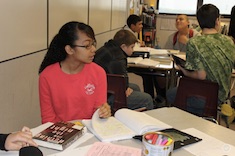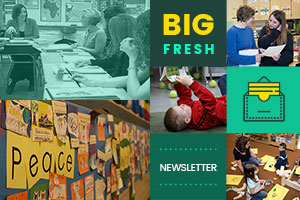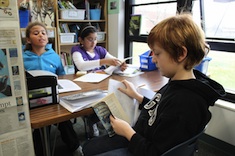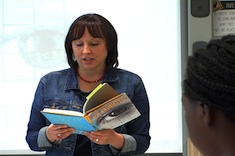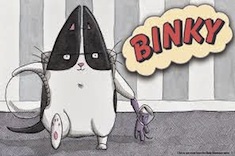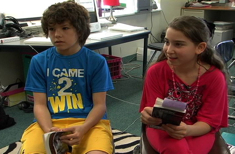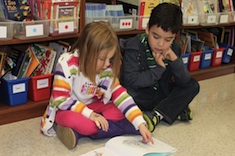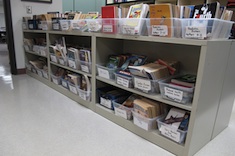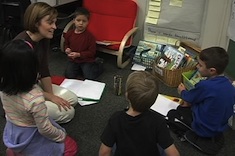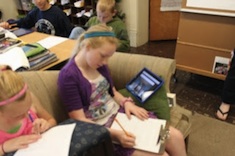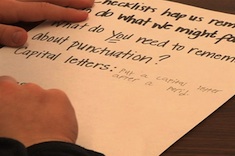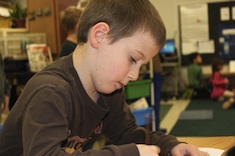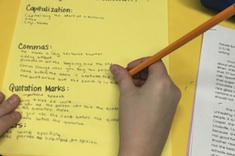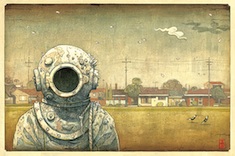Library
Choice Literacy Articles & Videos
The Choice Literacy library contains over 3,000 articles and 900 videos from 150+ contributors. Classic Classroom and Literacy Leadership subscribers have access to the entire library. Content is updated continuously, with five to six new features published each week.
Latest Content
The Professional Promise of Podcasts
Suzy Kaback discovers podcasts are invaluable for building her knowledge of social justice. She provides links to many of her favorite online sources to explore.
Writing for Reflection at the End of the Year
Katherine Sokolowski reflects on ways to extend the learning from an end-of-year activity all the way to the fall.
The Big Fresh May 21, 2016 Taking Play Seriously
Celebrations, reflections, and closing out the year are featured in this week’s Big Fresh.
End-of-the-Year Reflection
Melanie Meehan shares a series of thoughtful questions to help students reflect on their process as writers, and what they need as they move into the summer and new classrooms.
Making Plans for Summer Reading
Tara Barnett and Kate Mills begin a few days before the start of break to help students develop summer reading goals and plans.
Amazing Race
Gretchen Schroeder uses the format of the Amazing Race television show to help her high school students master materials for final exams and get moving throughout the school for a fun break.
Five Steps to Meaningful Formal Celebrations
Ruth Ayres gives a step-by-step process for closing out the school year with a meaningful writing celebration that welcomes the entire community
The Big Fresh May 14, 2016 Taking a Break
Book sampling with teens and tweens is the focus of this week’s Big Fresh.
Trying on Books for Reading Groups
Gigi McAllister finds taking time to have students browse texts before forming book clubs makes all the difference in the quality of the discussions.
Getting Teens Out of Reading Ruts: The Sampler
Carly Ullmer describes the activity she’s developed for getting her middle school readers out of reading ruts by sampling different authors and genres.
A Formula for Great Book Talks
Christy Rush-Levine explains her formula for successful book talks in middle school that grab students' attention. We've also included a sample book talk.
The Big Fresh May 7, 2016 Gradual Release of the Library
Navigating classroom libraries is the focus of this week’s Big Fresh.
Graphic Novels for Beginning Readers
If you are looking to increase the quantity and quality of graphic novels for your learners in your classroom library, Shari Frost has a new booklist to get you started.
Gradual Release of the Library
Bitsy Parks explains how she designs her first-grade classroom library for “gradual release” throughout the school year in a way that allows students to build book-browsing skills.
The Big Fresh April 30, 2016 Dog Days and Watermelon
Peers helping peers is the focus of this week’s Big Fresh.
Building Annotation Skills with Partners
Gretchen Taylor works from homework surveys to help her middle school students collaborate with partners to build annotation skills.
Purposeful Partners
Tara Barnett and Kate Mills find the young learners in their classroom have mastered the art of turning and talking only with close friends. They provide practical suggestions for expanding the circle of peer response.
Hot Glue Guns
Mary Lee Hahn considers the use of Hot Glue Guns in her classroom, and moves from exasperation to appreciating the learning happening when we think kids are just messing around with peers and the tools we've given them.
Culturally Responsive Texts
Katrina Edwards is horrified when a student response reveals cultural gaps in her first-grade classroom library. She researches possibilities for expanding the diversity of texts, and shares an annotated bibliography to download linking different cultures and curricular possibilities.
Adjusting the Classroom Library for Student Needs
Mandy Robek realizes her classroom library isn’t working for her second graders, in part because many of the books are still too difficult for students early in the year. She explains her process of sorting and stowing books for later use.
The Big Fresh April 23, 2016 Standardized Test Unpreparation
Daily assessments are the focus of this week’s Big Fresh.
Choosing and Refining Student Goals
Katie DiCesare shares the process of having her first graders choose their literacy goals, and her role in helping them refine goals through observation and conferring.
Revising Weekly Reflections
Katherine Sokolowski revises the weekly reflection form her fifth graders use to ensure everyone is tracking goals, progress, and expectations.
A Place to Belong
Andrea Smith reflects on preparing to say goodbye to students and her teaching partner of many years. If you have a favorite colleague who is retiring, you may want to get a hankie ready before you read this one.
The Big Fresh April 16, 2016 Thought Partners
Conventions and punctuation are the focus of this week’s Big Fresh.
Developing Individualized Convention Checklists with Students
Melanie Meehan works with third graders to develop personalized conventions checklists.
Alternatives to Daily Editing as a “Bell-Ringer” Activity
The “daily edit” is a common routine in many classrooms. Shari Frost explains why this may not be an effective way to teach conventions, and offers some alternatives.
An Individualized Conventions Checklist
Melanie Meehan finds that a flexible conventions checklist that students develop according to their own needs is the best way to ensure conventions are taught in the context of authentic student work.
Deep Reading of Picture Books in Middle School
Christy Rush-Levine shows the power of using picture books with young adolescents to model close reading and deepen comprehension of sophisticated texts.
The Big Fresh April 9, 2016 Slow Swimmer
We look at modeling and mirroring in this week’s Big Fresh.
Browse Content By
Type
Category
- Assessment Tools
- Big Fresh Archives
- Booklists
- Choice Numeracy
- Classroom Design
- Common Core
- Community Building
- Conferring
- Content Literacy
- Digital Literacy
- English Language Learners
- Equity
- Family Relations
- Free Samples
- Guiding Groups
- Leadership
- Literacy Coaches
- Mentor Texts
- Minilessons
- New Teacher Mentors
- Podcasts
- Poetry
- Quote Collections
- Reading Strategies
- Self Care
- Struggling and Striving Learners
- Talking and Listening
- Teacher Study Groups
- Teaching Reading
- Teaching Writing
- Word Study and Vocabulary
Author
- Melissa Quimby
- Nawal Qarooni
- Gwen Blumberg
- Julie Cox
- The Lead Learners
- Hannah Tills
- Josie Stewart
- Ruth Metcalfe
- Mallory Messenger
- Becca Burk
- Jodie Bailey
- Vivian Chen
- Mary Brower
- Tiffany Abbott Fuller
- Stephanie Affinito
- Ruth Ayres
- Leigh Anne Eck
- Heather Fisher
- Shari Frost
- Julie Johnson
- Suzy Kaback
- Gigi McAllister
- Shirl McPhillips
- Melanie Meehan
- Cathy Mere
- Debbie Miller
- Tara Barnett and Kate Mills
- Tammy Mulligan
- Dana Murphy
- Bitsy Parks
- David Pittman
- Brenda Power
- Heather Rader
- Matt Renwick
- Mandy Robek
- Christy Rush-Levine
- Gretchen Schroeder
- Jen Schwanke
- Brian Sepe
- Katherine Sokolowski
- Stella Villalba
- Jennifer Vincent
Grade Level
Choice Literacy Membership
Articles
Get full access to all Choice Literacy article content
Videos
Get full access to all Choice Literacy video content
Courses
Access Choice Literacy course curriculum and training

